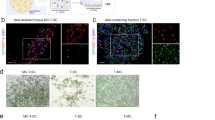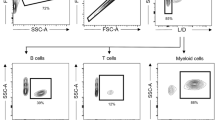Abstract
Transplantation of allogeneic pancreatic islets is an effective approach to treat type 1 diabetes. To bypass the need for systemic administration of immunosuppression drugs following transplantation, approaches to genetically modify allogeneic islets to express anti-inflammatory, immunosuppressive, or antiapoptotic proteins prior to transplantation are being developed. Adeno-associated viral (AAV) based vectors have been used for gene transfer to islets, but the efficiency of functional transduction is low. Recently, double-stranded (ds) or double-copy (dc) based AAV vectors have been developed that allow for more rapid and efficient AAV-mediated transgene expression following transduction. Here we demonstrate that intact human and murine islets can be transduced with dsAAV2-eGFP efficiently compared to single-stranded AAV2-eGFP. Furthermore, our results demonstrate that murine islets transduced with dsAAV2-eGFP have normal islet glucose responsiveness, viability, and islet insulin content. Transplantation of the dsAAV2-eGFP transduced islet restored normal glycemia in diabetic mice without eliciting an immune response. Significant dsAAV2-mediated eGFP expression was observed in the islet grafts for at least 6 months post-transplant. Finally, we demonstrated that dsAAV serotypes 2, 6, and 8 infect human islets efficiently. Taken together, these results suggest that dsAAV based vectors are highly appropriate for gene transfer to islets to facilitate transplantation.
This is a preview of subscription content, access via your institution
Access options
Subscribe to this journal
Receive 12 print issues and online access
$259.00 per year
only $21.58 per issue
Buy this article
- Purchase on Springer Link
- Instant access to full article PDF
Prices may be subject to local taxes which are calculated during checkout






Similar content being viewed by others
References
Atkinson MA, Maclaren NK . The pathogenesis of insulin-dependent diabetes mellitus. N Engl J Med 1994; 331: 1428–1436.
Loweth AC et al. Human islets of Langerhans express Fas ligand and undergo apoptosis in response to interleukin-1beta and Fas ligation. Diabetes 1998; 47: 727–732.
Pakala SV, Chivetta M, Kelly CB, Katz JD . In autoimmune diabetes the transition from benign to pernicious insulitis requires an islet cell response to tumor necrosis factor alpha. J Exp Med 1999; 189: 1053–1062.
Herrera PL, Harlan DM, Vassalli P . A mouse CD8T cell-mediated acute autoimmune diabetes independent of the perforin and Fas cytotoxic pathways: possible role of membrane TNF. Proc Natl Acad Sci USA 2000; 97: 279–284.
Kreuwel HT et al. Comparing the relative role of perforin/granzyme versus Fas/Fas ligand cytotoxic pathways in CD8+ T cell-mediated insulin-dependent diabetes mellitus. J Immunol 1999; 163: 4335–4341.
Shapiro AM et al. Islet transplantation in seven patients with type 1 diabetes mellitus using a glucocorticoid-free immunosuppressive regimen. N Engl J Med 2000; 343: 230–238.
Hirshberg B et al. State of the art: islet transplantation for the cure of type 1 diabetes mellitus. Rev Endocr Metab Disord 2003; 4: 381–389.
Gaglia JL, Harlan DM . Transplantation tolerance. Curr Dir Autoimmun 2001; 4: 283–307.
Harlan DM, Kirk AD . The future of organ and tissue transplantation: can T-cell costimulatory pathway modifiers revolutionize the prevention of graft rejection? JAMA 1999; 282: 1076–1082.
Paty BW, Harmon JS, Marsh CL, Robertson RP . Inhibitory effects of immunosuppressive drugs on insulin secretion from HIT-T15 cells and Wistar rat islets. Transplantation 2002; 73: 353–357.
Gallichan WS et al. Lentivirus-mediated transduction of islet grafts with interleukin 4 results in sustained gene expression and protection from insulitis. Hum Gene Ther 1998; 9: 2717–2726.
Deng S et al. IL-10 and TGF-beta gene transfer to rodent islets: effect on xenogeneic islet graft survival in naive and B-cell-deficient mice. Transplant Proc 1997; 29: 2207–2208.
Bertera S et al. Gene transfer of manganese superoxide dismutase extends islet graft function in a mouse model of autoimmune diabetes. Diabetes 2003; 52: 387–393.
Gainer AL et al. Expression of CTLA4-Ig by biolistically transfected mouse islets promotes islet allograft survival. Transplantation 1997; 63: 1017–1021.
Contreras JL et al. Cytoprotection of pancreatic islets before and soon after transplantation by gene transfer of the anti-apoptotic Bcl-2 gene. Transplantation 2001; 71: 1015–1023.
Tobiasch E, Gunther L, Bach FH . Heme oxygenase-1 protects pancreatic beta cells from apoptosis caused by various stimuli. J Invest Med 2001; 49: 566–571.
Csete ME et al. Adenoviral-mediated gene transfer to pancreatic islets does not alter islet function. Transplant Proc 1994; 26: 756–757.
Csete ME et al. Efficient gene transfer to pancreatic islets mediated by adenoviral vectors. Transplantation 1995; 59: 263–268.
Giannoukakis N et al. Infection of intact human islets by a lentiviral vector. Gene Therapy 1999; 6: 1545–1551.
Ju Q et al. Transduction of non-dividing adult human pancreatic beta cells by an integrating lentiviral vector. Diabetologia 1998; 41: 736–739.
Curran MA et al. Efficient transduction of pancreatic islets by feline immunodeficiency virus vectors1. Transplantation 2002; 74: 299–306.
Bottino R, Lemarchand P, Trucco M, Giannoukakis N . Gene- and cell-based therapeutics for type I diabetes mellitus. Gene Therapy 2003; 10: 875–889.
Flotte T et al. Efficient ex vivo transduction of pancreatic islet cells with recombinant adeno-associated virus vectors. Diabetes 2001; 50: 515–520.
Kapturczak M et al. Transduction of human and mouse pancreatic islet cells using a bicistronic recombinant adeno-associated viral vector. Mol Ther: J Am Soc Gene Ther 2002; 5: 154–160.
Yang YW, Kotin RM . Glucose-responsive gene delivery in pancreatic islet cells via recombinant adeno-associated viral vectors. Pharmaceut Res 2000; 17: 1056–1061.
Berns KI, Giraud C . Biology of adeno-associated virus. Curr Top Microbiol Immunol 1996; 218: 1–23.
Afione SA et al. Delayed expression of adeno-associated virus vector DNA. Intervirology 1999; 42: 213–220.
Ferrari FK, Samulski T, Shenk T, Samulski RJ . Second-strand synthesis is a rate-limiting step for efficient transduction by recombinant adeno-associated virus vectors. J Virol 1996; 70: 3227–3234.
Alexander AM et al. Indoleamine 2,3-dioxygenase expression in transplanted NOD islets prolongs graft survival after adoptive transfer of diabetogenic splenocytes. Diabetes 2002; 51: 356–365.
Barrou B et al. Prolonged islet allograft survival by adenovirus-mediated transfer of sICAM-1/Ig immunoadhesin gene. Hum Gene Ther 2002; 13: 1441–1450.
Feng S et al. Prolonged xenograft survival of islets infected with small doses of adenovirus expressing CTLA4Ig. Transplantation 1999; 67: 1607–1613.
Sutherland RM et al. Protective effect of CTLA4Ig secreted by transgenic fetal pancreas allografts. Transplantation 2000; 69: 1806–1812.
Wang Z et al. Rapid and highly efficient transduction by double-stranded adeno-associated virus vectors in vitro and in vivo. Gene Therapy 2003; 10: 2105–2111.
Giannoukakis N, Trucco M . Current status and prospects for gene and cell therapeutics for type 1 diabetes mellitus. Rev Endocr Metab Disord 2003; 4: 369–380.
Loiler SA et al. Targeting recombinant adeno-associated virus vectors to enhance gene transfer to pancreatic islets and liver. Gene Therapy 2003; 10: 1551–1558.
Zhang YC et al. Immunity to adeno-associated virus serotype 2 delivered transgenes imparted by genetic predisposition to autoimmunity. Gene Therapy 2004; 11: 233–240.
Giannoukakis N, Trucco M . Autoimmunity and gene therapy: The nemesis of autoimmunity. Gene Therapy 2004; 11: 231–232.
Xiao X, Li J, Samulski RJ . Production of high-titer recombinant adeno-associated virus vectors in the absence of helper adenovirus. J Virol 1998; 72: 2224–2232.
Gao GP et al. Novel adeno-associated viruses from rhesus monkeys as vectors for human gene therapy. Proc Natl Acad Sci USA 2002; 99: 11854–11859.
Rabinowitz JE et al. Cross-packaging of a single adeno-associated virus (AAV) type 2 vector genome into multiple AAV serotypes enables transduction with broad specificity. J Virol 2002; 76: 791–801.
Rutledge EA, Halbert CL, Russell DW . Infectious clones and vectors derived from adeno-associated virus (AAV) serotypes other than AAV type 2. J Virol 1998; 72: 309–319.
Snyder R, Xiao X, Samulski RJ . Production of recombinant adeno-asociated viral vectors. In: Smith D (ed). Current Protocols in Human Genetics. John Wiley & Sons Ltd: New York, 1996, pp 12.1.1–12.2.23.
Rehman KK et al. Protection of islets by in situ peptide-mediated transduction of the Ikappa B kinase inhibitor Nemo-binding domain peptide. J Biol Chem 2003; 278: 9862–9868.
Bottino R et al. Preservation of human islet cell functional mass by anti-oxidative action of a novel SOD mimic compound. Diabetes 2002; 51: 2561–2567.
Lorenzo A, Razzaboni B, Weir GC, Yankner BA . Pancreatic islet cell toxicity of amylin associated with type-2 diabetes mellitus. Nature 1994; 368: 756–760.
Like AA, Appel MC, Williams RM, Rossini AA . Streptozotocin-induced pancreatic insulitis in mice. Morphologic and physiologic studies. Lab Invest 1978; 38: 470–486.
Hogan B, Beddington R, Costantini F, Lacy E . Avertin, anesthetic. In: Inglis J, Cuddihy J (eds). Manipulating the Mouse Embryo, A Laboratory Manual, 2nd edn. Cold Spring Harbor Laboratory Press: ME, 1994, pp 416.
Tatarkiewicz K et al. Reversal of hyperglycemia in mice after subcutaneous transplantation of macroencapsulated islets. Transplantation 1999; 67: 665–671.
Acknowledgements
This work was supported in part by grants from the JDRF (#4-1999-845) and the ADA (ADA# 1-04-ISLET-23).
Author information
Authors and Affiliations
Rights and permissions
About this article
Cite this article
Rehman, K., Wang, Z., Bottino, R. et al. Efficient gene delivery to human and rodent islets with double-stranded (ds) AAV-based vectors. Gene Ther 12, 1313–1323 (2005). https://doi.org/10.1038/sj.gt.3302530
Received:
Accepted:
Published:
Issue Date:
DOI: https://doi.org/10.1038/sj.gt.3302530
Keywords
This article is cited by
-
Investigating the link of ACAD10 deficiency to type 2 diabetes mellitus
Journal of Inherited Metabolic Disease (2018)
-
Overcoming Insulin Insufficiency by Forced Follistatin Expression in β -cells of db/db Mice
Molecular Therapy (2015)
-
Simultaneous silencing of multiple RB and p53 pathway members induces cell cycle reentry in intact human pancreatic islets
BMC Biotechnology (2014)
-
Expression of IL-2 in β cells by AAV8 gene transfer in pre-diabetic NOD mice prevents diabetes through activation of FoxP3-positive regulatory T cells
Gene Therapy (2014)
-
Delivery of inhibitor of growth 4 (ING4) gene significantly inhibits proliferation and invasion and promotes apoptosis of human osteosarcoma cells
Scientific Reports (2014)



